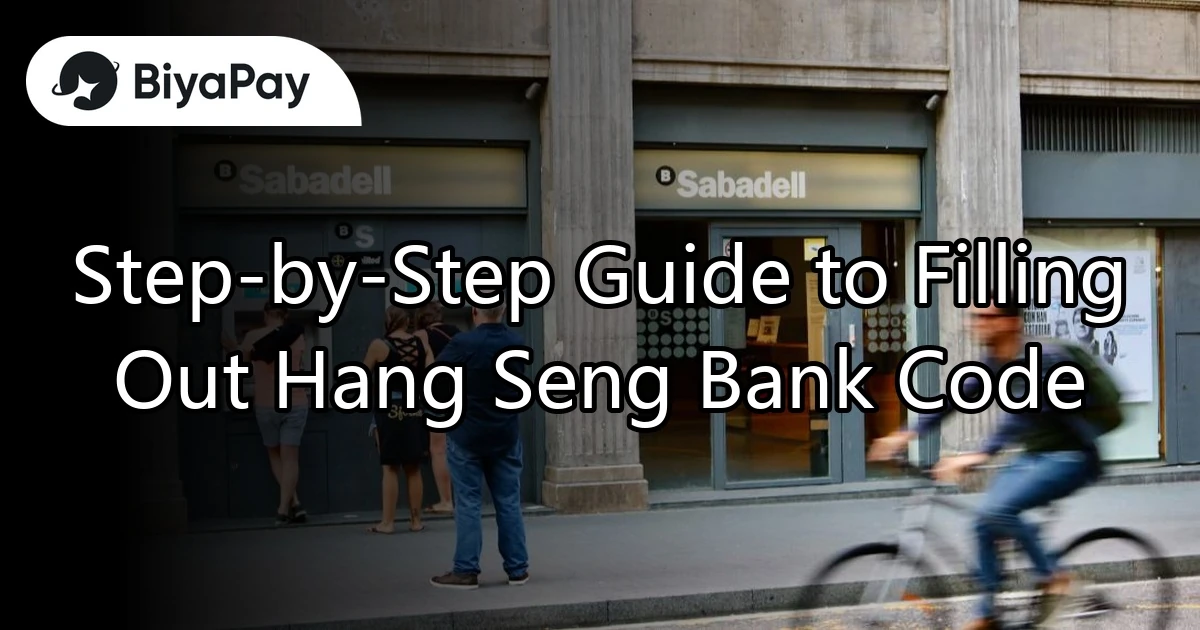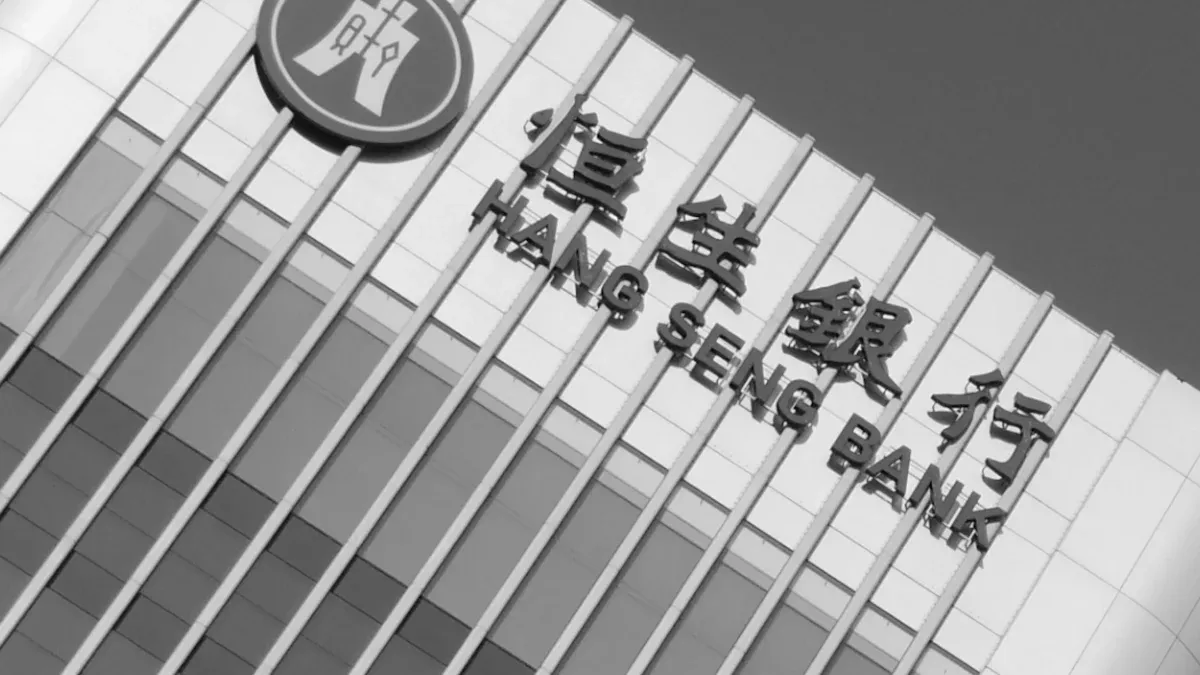- EasyCard
- Trade
- Help
- Announcement
- Academy
- SWIFT Code
- Iban Number
- Referral
- Customer Service
- Blog
- Creator
Step-by-Step Guide to Filling Out Hang Seng Bank Code

Image Source: pexels
When handling transfers, payroll accounts, or payments, you must correctly fill out Hang Seng Bank code “024,” branch code, and account number. If these details are entered incorrectly, funds may be delayed or even transferred to the wrong account. You should carefully check each piece of information. It is recommended to refer to your bank statement or Hang Seng Bank’s official website to ensure all details are correct, reducing common errors.
Key Points
- The Hang Seng Bank code is “024,” which must be filled out accurately to ensure funds reach the designated account smoothly.
- When filling out bank forms, distinguish between bank code, branch code, and account number, and verify details using your bank statement or official website.
- Fill out all details in clear English block letters, and place check marks where required to minimize errors.
- Double-check details before and after filling out forms to avoid delays or failures due to incorrect information.
- The filling method is similar for different purposes like online transfers, payroll accounts, or payments, with the key being to ensure complete and accurate details.
Hang Seng Bank Code
What is a Bank Code
When handling bank transfers or international remittances, you often encounter the term “bank code.” A bank code is a unique set of numbers used to identify a bank. You can think of it as a bank’s identification number. Each bank has its own exclusive bank code to ensure funds are accurately sent to the correct bank.
- The bank code (SWIFT Code) is defined by the “Society for Worldwide Interbank Financial Telecommunication,” typically consisting of 8 to 11 letters or numbers.
- This code is mainly used for wire transfers between international banks, making the payment process standardized and secure.
- The SWIFT system connects over 11,000 financial institutions across 200 countries and regions.
- When using a bank code, you can clearly identify the bank and branch, reducing remittance errors.
- In international financial transactions, the bank code is crucial. For example, during the Russia-Ukraine conflict, international sanctions on Russian banks involved expelling them from the SWIFT system, cutting off international fund flows.
Each time you fill out a bank form, you must ensure the bank code is correct. This can prevent fund delays or erroneous transfers.
Hang Seng Bank Code “024”
When using Hang Seng Bank services in Hong Kong, you must know that the Hang Seng Bank code is “024.” This code is the unique identifier for Hang Seng Bank within Hong Kong’s banking system. Whether you are performing online transfers, registering a payroll account, or making payments, you need to correctly fill out the Hang Seng Bank code on forms.
Tip: You can find the Hang Seng Bank code “024” on the official website, bank statements, or passbook. It’s recommended to verify it each time before filling out forms to ensure accuracy.
When filling out forms, you typically see three fields: bank code, branch code, and account number. You must enter “024” in the bank code field so the banking system can correctly identify your bank. As long as you fill out the Hang Seng Bank code correctly, funds will reach the designated account smoothly.
| Field Name | Information to Fill | Example |
|---|---|---|
| Bank Code | Hang Seng Bank Code | 024 |
| Branch Code | Your Branch’s Code | 123 |
| Account Number | Your Bank Account Number | 456789001234 |
Each time you fill out these details, remember to use English block letters and place check marks in appropriate boxes. This reduces the chance of errors and ensures fund safety.
Form Filling Steps

Image Source: unsplash
When filling out bank forms for different purposes, the steps may vary slightly. Below, we cover three common scenarios—online bank transfers, payroll accounts/automatic transfers, and payments/collections—to help you master the correct filling method.
Online Bank Transfers
When using online banking for transfers, the system typically requires three details: bank code, branch code, and account number. You should follow these steps:
- Enter the Hang Seng Bank code “024” in the “Bank Code” field.
- Check your bank statement or passbook to find your branch’s code and enter the correct digits.
- Fill in your complete bank account number in the “Account Number” field.
- It’s recommended to use clear English block letters for all details to ensure readability.
- Verify all details are correct before clicking confirm.
Tip: Some online banking platforms may auto-fill the Hang Seng Bank code, but you should still double-check to avoid errors.
Payroll Accounts/Automatic Transfers
When applying for a payroll account or setting up automatic transfers, you typically need to fill out an authorization form. These forms have designated fields for bank details. You can follow these steps:
- Enter “024” in the “Bank Code” field.
- Fill in your branch’s three-digit code in the “Branch Code” field.
- Enter your bank account number in the “Account Number” field.
- Use English block letters for all details and place check marks (✔) where required.
- Before submitting the form, double-check all details against your bank statement or official website.
Note: If you enter the wrong Hang Seng Bank code, payroll or automatic transfers may fail, causing fund delays.
Payments and Collections
When paying tuition, utilities, or receiving funds, you often need to provide bank details to the other party. You can fill out the details as follows:
- Enter “024” in the “Bank Code” field.
- Check and correctly fill in your three-digit branch code.
- Enter your complete account number in the “Account Number” field.
- It’s recommended to use English block letters to avoid unclear handwriting.
- Some forms may require check marks next to details to confirm verification.
| Purpose | Bank Code | Branch Code | Account Number |
|---|---|---|---|
| Online Transfer | 024 | 123 | 456789001234 |
| Payroll Account | 024 | 234 | 567890123456 |
| Payment/Collection | 024 | 345 | 678901234567 |
Reminder: Before filling out forms, refer to your bank statement or official website to ensure all details are correct, minimizing errors.
Precautions for Accurate Filling
Distinguishing Bank Code, Branch Code, and Account Number
When filling out bank forms, you must clearly distinguish three details: bank code, branch code, and account number. The bank code identifies your bank, such as Hang Seng Bank’s “024.” The branch code represents the branch where you opened your account, with each branch having a unique three-digit code. The account number is your personal bank account number. By correctly filling out these three details, the banking system can accurately process your funds.
Tip: You can find these details on your bank statement, passbook, or Hang Seng Bank’s official website. It’s recommended to verify them before filling out forms to reduce errors.
Common Errors and How to Avoid Them
The most common errors when filling out bank details include:
- Entering the wrong bank code, causing funds to be transferred to another bank.
- Writing the incorrect branch code, preventing funds from being credited correctly.
- Omitting or adding digits to the account number, resulting in transfer failures.
- Inconsistent data formats, such as mixing numerals with Chinese characters or using non-uniform date formats.
According to The Business Research Company, the data cleansing tools market is expected to grow at a 17% CAGR to USD 5.8 billion by 2028 (approximately HKD 45.3 billion at 1 USD to 7.8 HKD), reflecting the growing importance of data accuracy. Industry statistics also indicate that outdated or missing data reduces data value, and inconsistent formats cause processing difficulties.
You can reduce errors by following these methods:
- Verify details against your bank statement or official website before filling out forms.
- Use clear English block letters to ensure readability.
- Double-check all details after filling out forms to ensure accuracy.
Note: By carefully verifying and correctly filling out the Hang Seng Bank code, branch code, and account number, you can significantly reduce the risk of fund delays or erroneous transfers.
Example Demonstration

Image Source: pexels
Text Example
When filling out a bank form, you must enter the bank code, branch code, and account number in sequence. For example, if you opened an account at Hang Seng Bank’s Central branch with a branch code of “382” and an account number of “123456789001,” you should fill it out as follows:
- Bank Code: 024
- Branch Code: 382
- Account Number: 123456789001
Tip: You can find the branch code and account number on your bank statement or passbook. Verify them before filling out forms to ensure accuracy.
The filling method is the same for different purposes. As long as the details are correct, funds will safely reach the designated account.
Actual Filling Format
You can refer to the following table for the correct filling format:
| Field Name | Content to Fill | Example |
|---|---|---|
| Bank Code | 3-digit number | 024 |
| Branch Code | 3-digit number | 382 |
| Account Number | 12-digit number | 123456789001 |
When filling out forms, it’s recommended to write in English block letters. This makes it easier for bank staff to read, reducing errors.
Note: Some forms may require check marks next to each field to confirm verification. Follow the form’s instructions.
Each time you fill out a bank form, double-check all details. Correctly entering the bank code, branch code, and account number ensures secure fund transfers.
If you have questions, refer to Hang Seng Bank’s official website or contact the bank directly.
Remember, the Hang Seng Bank code “024” is critical information you must keep in mind.
FAQ
Where can I find the Hang Seng Bank code?
You can find the bank code on Hang Seng Bank’s official website, bank statements, or passbook. It’s recommended to verify details before filling out forms.
What’s the difference between a branch code and a bank code?
The bank code identifies the bank, such as Hang Seng Bank’s “024.” The branch code represents the branch where you opened your account, with each branch having a unique three-digit code.
What happens if I fill out the wrong bank code?
If you enter the wrong bank code, funds may be transferred to another bank. This can cause delays or losses. You should carefully check each time.
Do I need to fill out the entire account number?
You must fill out the complete account number. Omitting or adding digits will cause transfer failures. Refer to your bank statement to confirm the correct number.
How should I fill out details for transfers to Hang Seng Bank in Hong Kong from China or other regions?
You need to fill out the Hang Seng Bank code “024,” branch code, and complete account number. For international remittances, also provide the SWIFT Code (HASEHKHH). Check the latest exchange rate (e.g., 1 USD ≈ 7.8 HKD).
In 2025, accurately filling in Hang Seng Bank’s bank code “024” is crucial for seamless local transfers, salary accounts, or bill payments. BiyaPay enhances your financial management with a single account for Hong Kong and U.S. stock trading and a wealth management product offering up to 5.48% annualized return, accessible anytime with flexible withdrawals—no additional overseas accounts needed. Start now at BiyaPay!
BiyaPay supports real-time conversions across multiple fiat and digital currencies with transparent rate queries, minimizing costs with remittance fees as low as 0.5%. Regulated by international financial authorities, it ensures secure, reliable transactions, streamlining local and cross-border fund flows for enhanced efficiency. Visit BiyaPay today to seize financial opportunities!
*This article is provided for general information purposes and does not constitute legal, tax or other professional advice from BiyaPay or its subsidiaries and its affiliates, and it is not intended as a substitute for obtaining advice from a financial advisor or any other professional.
We make no representations, warranties or warranties, express or implied, as to the accuracy, completeness or timeliness of the contents of this publication.




Contact Us
Company and Team
BiyaPay Products
Customer Services
is a broker-dealer registered with the U.S. Securities and Exchange Commission (SEC) (No.: 802-127417), member of the Financial Industry Regulatory Authority (FINRA) (CRD: 325027), member of the Securities Investor Protection Corporation (SIPC), and regulated by FINRA and SEC.
registered with the US Financial Crimes Enforcement Network (FinCEN), as a Money Services Business (MSB), registration number: 31000218637349, and regulated by FinCEN.
registered as Financial Service Provider (FSP number: FSP1007221) in New Zealand, and is a member of the Financial Dispute Resolution Scheme, a New Zealand independent dispute resolution service provider.




















